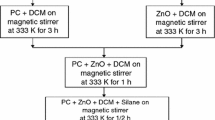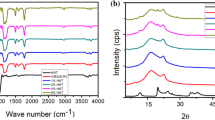Abstract
The thermally stimulated discharge current (TSC) and differential scanning calorimetry (DSC) spectroscopy have been recorded in 25 μm thick samples of pristine polycarbonate (PC) and zinc oxide nano particle-filled polycarbonate. Polycarbonate (PC)/zinc oxide (ZnO) nanocomposites of different mass ratio (e.g., 1, 3, and 5%) were prepared by sol–gel method, followed by film casting. The glass transition temperature of nanocomposite samples increases with increase in concentration of ZnO nano fillers. It is due to the strong interaction between inorganic and organic components. The TSC peaks of nanocomposite and pristine PC indicate the multiple relaxation process. It has been observed that the magnitude of TSC decreases with increase in concentration of nanofillers. The TSC characteristics of 5% filled nanocomposites shows exponential increase of current at higher temperature region. This increase in current is caused by formation of charge-transfer complex between inorganic phase (e.g., ZnO) and organic phase (e.g., PC). Thus, the nano material like zinc oxide transfers the charge carriers from inorganic phase to organic phase rapidly and resultant current increases exponentially. This current is known as leakage current or breakdown current. TSC peak height is observed as a function of the polarizing field. The height of TSC peak increases as the field increases in pristine PC, while TSC peak height is suppressed in nanocomposite samples. This indicates the amount of space charge is smaller in the nanocomposites with a proper addition of ZnO nano fillers than in the pristine PC.








Similar content being viewed by others
References
Barabanova AI, Shevnin PL, Pryakhina TA, Bychko KA, Kazantseva V, Zavin BG, et al. Nanocomposites based on epoxy resin and silicon dioxide particles. Polym Sci Ser A. 2008;50:808–19.
Nam JD, Hwang SD, Choi HR, Lee J, Kim KJ, Heo S. Electrostrictive polymer nanocomposites exhibiting tunable electrical properties. Smart Mater Struct. 2005;14:87–90.
Godovsky DY. Device applications of polymer-nanocomposites. Adv Polym Sci. 2000;153:163–205.
Lewis TJ. Nanometric dielectrics. IEEE Trans Dielectr Electr Insul. 1994;5:812–25.
Tanaka T, Montanari GC, Mülhaupt R. Polymer nanocomposites as dielectrics and electrical insulation–perspectives for processing technologies, material characterization and future applications. IEEE Trans Dielectr Electr Insul. 2004;11:763–84.
Zhang C, Mason R, Stevens GC. Dielectric properties of alumina-polymer nanocomposites. Electr Insul Dielectr Phenom. 2005;16:721–4.
Shen Y, Lin YH, Nan CW. Interfacial effect on dielectric properties of polymer nanocomposites filled with core/shell-structured particles. Adv Funct Mater. 2007;17(14):2405–10.
Ning H, Masuda Z, Yan C, Yamamoto G, Fukunaga H, Hashida T. The electrical properties of polymer nanocomposites with carbon nanotube fillers. Nanotechnology. 2008;19:215701–10.
Koo JH. Polymer nanocomposites: processing, characterization and application. New York: McGraw-Hill Professional; 2006. p. 33.
Riande E, Daz-Calleja R. Electrical properties of polymers. Boca Raton: CRC Press; 2004. p. 374.
Torres JA, Nealy PF, Pablo DJJ. Molecular simulation of ultrathin polymeric films near the glass transition. Phys Rev Lett. 2000;85:3221–4.
Forrest JA, Dalnoki-Veress K, Dutcher JR. Interface and chain confinement effects on the glass transition temperature of thin polymer films. Phys Rev. 1997;E56:5705–16.
Fukao K, Miyamoto Y. Glass transition temperature and dynamics of α relaxation process in thin polymer films. Europhys Lett. 1999;46:649–54.
Gaur MS, Shukla P, Tiwari RK, Tanwar A, Singh SP. New approach for the measurement of glass transition temperature of polymer. Ind J Pure Appl Phys. 2008;46:535–9.
Turnhout JV. Thermally stimulated discharge of electrets. In: Sessler GM, editor. Topics in applied physics (Electrets). Berlin, Heidelberg: Springer-Verlag; 1980.
Richeret R, Blumen A, editors. Disordered effects on relaxation processes. Berlin, Heidelberg: Springer-Verlag; 1994.
Strobl G. The physics of polymers. Berlin, Heidelberg: Springer-Verlag; 1996.
Ibar JP. Do we need a new theory in polymer physics? Polym Rev. 1997;37:389–458.
Bernes A, Martinez JJ, Chatain D, Lacabanne C. Thermally stimulated current spectroscopy for the study of thermoplastics. J Therm Anal Calorim. 1991;37:1795–804.
Litt MH, Torp S. Strain and temperature dependence of relaxation phenomena in polycarbonate. J Appl Phys. 1973;44:4282–7.
Kluin JE, Yu Z, Vleeshouwers S, McGervey JD, Jamieson AM, Simha R. Temperature and time dependence of free volume in bisphenol—A polycarbonate studied by positron lifetime spectroscopy temperature and time dependence of free volume in bisphenol A polycarbonate studied by positron lifetime spectroscopy. Macromolecules. 1992;25:5089–93.
Aoki Y, Brittain JO. Isothermal and nonisothermal dielectric relaxation studies on polycarbonate. J Polym Sci B Polym Phys. 1976;14:1297–302.
Narula GK, Pillai PKC. Dielectric measurements in an amorphous polymer—Poly(methyl methacrylate). J Polym Sci B Polym Phys. 1990;42:469–72.
Bernes A, Chatain D, Lacabanne C. Thermally stimulated current study of relaxation in glassy polycarbonate. Polymer. 1992;33:4682–6.
Sauer BB, Avakian P, Howard W, Starkweather Jr. Cooperative relaxations in semicrystalline fluoropolymers studied by thermally stimulated currents and ac dielectric. J Polym Sci B Polym Phys. 1995;34:517–26.
Graeme JP, Michael J, Smith A. Multiple dielectric relaxation processes in an unequilibrated bisphenol-A polycarbonate. Polym Int. 1996;40:239–49.
Delbreilh L, Negahban M, Benzohra M, Lacabanne C, Saiter JM. Glass transition investigated by a combined protocol using thermostimulated depolarization currents and differential scanning calorimetry. J Therm Anal Calorim. 2009;96:865–71.
Alves NM, Ribelles JLG, Mano JF. Enthalpy relaxation studies in polymethyl methacrylate networks with different crosslinking degrees. Polymer. 2005;46:491–504.
Bacharan C, Dessaux C, Bernes A, Lacabanne C. Thermally stimulated current spectroscopy of amorphous and semi-crystalline polymers. J Therm Anal Calorim. 1999;56:969–82.
Rittigstein P, Torkelson JM. Polymer-nanoparticle interfacial interactions in polymer nanocomposites: confinement effects on glass transition temperature and suppression of physical aging. J Polym Sci B Polym Phys. 2006;44:2935–43.
Wei C, Shrivastava D, Cho K. Thermal expansion and diffusion coefficients of carbon nanotube-polymer composites. Nano Lett. 2002;2:647–50.
Chang JH, Seo B, Hwang DH. An exfoliation of organoclay in thermotropic liquid crystalline polyester nanocomposites. Polymer. 2002;43:2969–74.
Dixit M, Gupta S, Mathur V, Rathore KS, Sharma S, Saxena NS. Study of glass transition temperature of PPMA and CdS-PPMA composite. Chalcogenide Lett. 2009;6:131–6.
Xu W, Ge M, Pan WP. Glass transition temperature in polyvinyl chloride/monotmorillonite nanocomposite and mechanical properties. J Therm Anal Calorim. 2004;78:1–9.
Binder K, Baschnagel J, Bennemann C, Paul W. Monte Carlo and molecular dynamics simulation of the glass transition of polymers. J Phys Condens Matter. 1999;11:A47–55.
Acknowledgements
Author M. S. Gaur and Ajaypal Indolia are gratefully acknowledge the financial support of Defence Research Development Organization (DRDO), New Delhi, India (Vide letter no. ERIP/ER/0804419/M/01/1113). We are also thankful to Dr. A. Gupta, Director, UGC-DAE Consortium, Indore for providing DSC facility.
Author information
Authors and Affiliations
Corresponding author
Rights and permissions
About this article
Cite this article
Gaur, M.S., Rathore, B.S., Singh, P.K. et al. Thermally stimulated current and differential scanning calorimetry spectroscopy for the study of polymer nanocomposites. J Therm Anal Calorim 101, 315–321 (2010). https://doi.org/10.1007/s10973-010-0675-2
Received:
Accepted:
Published:
Issue Date:
DOI: https://doi.org/10.1007/s10973-010-0675-2




